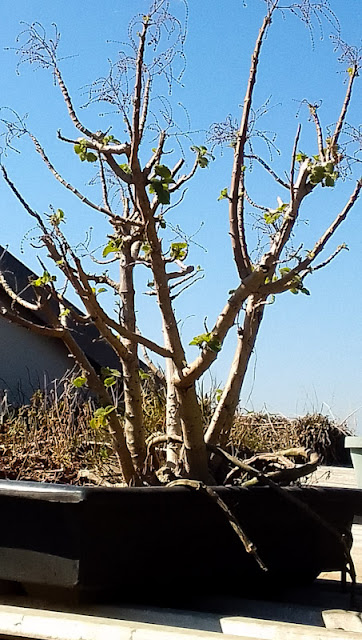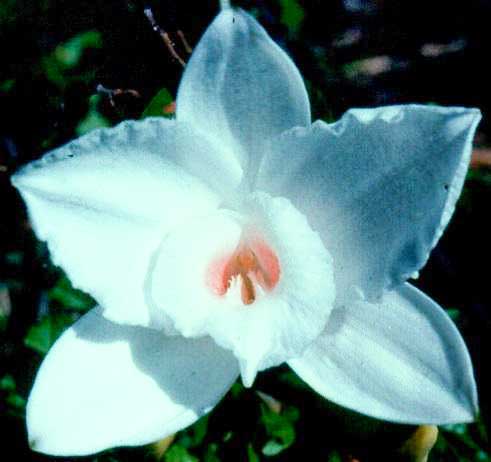A few notes on Growing South African Indigenous epiphytic
orchids.
Jumellea walleri
Our South African Indigenous epiphytic orchids can either be
grown on mounts as they grow in nature on trees or in pots however the majority
in particular the angreacoides with large fleshy roots do far better with their
roots fully exposed where they get both light and fresh air movement around
them which is most important for healthy growth.
Gold award winning Mystacidium braybonae with masses of healthy roots
Some of our orchids, in
particular the lithophytic orchids that grow on rocks and some Polystachya
species will do well in pots. The choice depends very much on which species one
is wanting to grow.
Mounts
Mounts can be made of branches cut from trees, driftwood, pieces
of hardwood such as Teak and balau. Mounts can also be made from plastic mesh
that are sown into flat bags and filled with suitable pine bark, coconut husk
moss or other suitable material which most grow well on, however they do not
look very nice. For some orchids a plastic pipe with large holes drilled into it
filled with coco husk chips is a very suitable mount ,
Vanilla roscheri grow exceptionally well on such a mount
Vanilla roscheri grow
exceptionally well on such a mount placed in a large pot so that the roots can grow
down into the growing medium in the pot. My own preference is teak when
available, when not Balau also makes long lasting mounts that my pants grow
well on.
Mystacidium pusillum growing indoors under LED lights
Pots and potting medium
Plastic pots are now the norm for growing orchids in pots
and more recently clear plastic orchid pots are available which benefit Angraecoid
Orchids with large fleshy roots that photosynthesize. As a growing medium I
have the best results with many of the orchids growing them on blocks of
differing sizes depending on the amount of ventilation the roots of each
species grown need when grown in pots, cut from both teak and balau wood. Belau
wood which is from various Shorea species is also known as Bangkirai wood.
Ansellia africana growing indoors
For lithophytes such as Tridactyle bicaudata subsp. rupestris,
Rangaeris muscicola Polystachya pubescens and a few others, I use sandstone chips
which they grow very well on. Sandstone chips in various sizes can be bought
from suppliers of landscaping materials.
Tridactyle bicaudata subsp. rupestris growing in full sun
When to repot
The best time to split or repot monopodial growth orchids
such as the angreacoides is when the plants are in active growth having just
initiated new root growth. With Sympodial growth orchids they must be split or
repotted just as the new pseudobulbs start
forming from the base of the previous pseudobulb.
If orchid plants are split in their dormant period many
species become very dehydrated or even die before the new growth starts.
Watering
This is the most problematic factor to define when growing
orchids. There are so many factors to consider that vary from plant to plant
and from area to area where the plants are being grown. The only advice I can
give is to watch and get to know the growth requirements of the plants being grown and water to satisfy
the plant’s needs. The watering requirements will vary in response to weather
conditions, the time of year and the stage of growth of the plants. With good
observation and experience, one will master this difficult aspect of growing vigorous
healthy orchid plants.
Cyrtorchis praetermissa subsp. zuluensis
Most of my local indigenous orchid plants are growing
indoors and get watered everyday year around and occasionally twice a day in
the hottest summer days when I have fans running. In the hot summer months,
they get watered with room temperature tap water and in the cooler months they
get watered with hot water out of the
geyser. The plants growing outdoors get watered most days when they have not received
rain in the summer months and once or twice a week during the cooler winter
months.
It is important that the plants are drenched at each
watering.
Feeding
Feeding of our indigenous orchids is most important for vigorous
and healthy growth. Because they come out of the bush where no one feeds them is
no reason to not feed them in cultivation if one wants to grow healthy plants.
Microcoelia obovata growing indoors under LED lights in flower
I feed my plants with a vast range of different plant feeds
and growth promoting agents such as Marinure, Seagro, Nitrosol, hydroponic
plant feed, black tea, rooibos tea, cinnamon tea, using a different feed every
week. Marinure, Seagro, Nitrosol, hydroponic plant feed I apply at 25 percent
of the recommended application rate. For black green and rooibos tea one teabag
per 5 liters of water. For cinnamon tea a few sticks of true cinnamon sticks are
soaked in boiling water per 5 liters of water.
True Cinnamon is the inner bark of the tree, Cinnamomum verum
belonging to the plant family Lauraceae.
Occasionally the plants should be soaked for at least 15
minutes in a bucket of clean water if grown indoors to prevent the harmful
build up of salts in and on the plant and on the mount that can lead to sudden
death if not removed.
Light
The amount of light that epiphytic orchids species require
varies considerably from species to species from full sun to deep forest shade
therefore it is vital to know the light requirements of the orchid species one
intends to grow if one intends to grow good healthy plants that flower well. As
a rule of thumb orchids that grow fully exposed to the sun will grow under 50
percent shade cloth and plants that grow in deep forest shade will survive
under 50 to 80 percent shade. In both cases the plants will not grow to their
full potential.
Ansellia africana growing indoors with pure yellow flowers
Orchid plants grow better, are more healthy and are less
prone to fungal and bacterial diseases if grown under a well-constructed lath
roof than under shade cloth.
All the orchid plants that I have trialed indoors under artificial
lighting using general purpose LED light strips have grown very well.
Ventilation and spacing of plants.
Good ventilation is essential for growing epiphytic orchids
in particular in the hot and humid summer months, in particular if grown
indoors. During the summer the windows remain open day and night and I have
fans running from first light until about 2100 hrs in the evening, I have the fans
running to ensure good air movement. To assist in the plants getting adequate
light and ventilation which considerably reduces fungus and bacterial attack,
the plants must be placed on a slatted or mesh covered bench and have plenty of
space between them. Failure to do this will result in constant infestations of
fungal and bacterial diseases and the total loss of plants.
Prevention and treatment of Fungus and bacteria diseases
When growing orchid plants prevention is far better than
cure, once and orchid plant has become infected by a fungal or bacterial
disease it is often very difficult to cure it. In advanced cases it is far
better to place the plant in a plastic bag, tie it up and put the plant in the
bin. I find regular preventative spraying with a fungicide such as Dithane M45 which
is an organic broad-spectrum protectant fungicide alternated with Benomyl together
with good plant hygiene keeps my plants free of disease.
Aerangis mystacidii growing indoors in low light in flower
Virus infection.
There is no cure for virus infections, immediately destroy suspected
infected plants because virus can spread fast through and entire orchid
collection making it valueless. Here prevention is the only cure.
Scale and mealie bug.
Both scale insects and mealie bugs attack orchid plants so
keep a good look out for infestations and spray immediately. As a precaution it
is advisable to spray the entire collection every couple of months to keep the
plants pest free. There are many suitable insecticides on the market that are relatively
nontoxic to pets and to humans.
Treatment of new plants
Be very careful when obtaining new plants, never accept or
introduce unhealthy plants into your collection in the hope you may be able to save
them, this could and probably will end up in tears
All new plants brought into my collection are kept separate
from my collection where they are first inspected then soaked in a suitable
insecticide for 10 to 15 minutes followed after a day or two by being soaked in
a solution of Benomyl, followed by a soaking in a solution of Dithane M45 a day
later. Only thereafter are they introduced to the other plants. It pays to be
safe rather than to be sorry.
Orchid roots
Strong healthy roots are the key to growing healthy orchid plants.
Just a glance at the roots of an orchid plant gives a very good indication of
how well the plant has been grown and how healthy it is.
Good healthy orchid roots
|
I have the following orchid species growing
well indoors
|
|
Acampe pachyglossa
Aerangis kirkii
Aerangis mystacidii
Angraecum
cultriforme
Bulbophyllum
sandersonii
Bulbophyllum
scaberulum
Bulbophyllum longiflorum
Cheirostylis nuda
Ansellia africana
Bolusiella maudiae
Cyrtorchis arcuate
Cyrtorchis praetermissa subsp.
Zuluensis
Diaphananthe millarii
Eulophia clitellifera
Eulophia parviflora
Eulophia petersii
Eulophia streptopetala
Microcoelia aphylla
Microcoelia exilis
Microcoelia obovata
Mystacidium aliceae
|
Mystacidium capense
Mystacidium gracile
Mystacidium venosum
Oeceoclades lonchophylla
Oeceoclades maculata
Polystachya concreta
Polystachya fusiformis
Polystachya modesta
Polystachya ottoniana
Polystachya pubescens
Polystachya sandersonii
Polystachya tayloriana
Polystachya valentina
Rangaeris muscicola
Rhipidoglossum rutilum
Stenoglottis fimbriata
Stenoglottis inandensis
Stenoglottis woodii
Tridactyle bicaudata subsp.
rupestris
Tridactyle tridentata
Vanilla roscheri
|
ALL that I have written above applies to most foreign
epiphytic orchids.
Some technical data on the two fungicides that I use.
Mancozeb (dithiocarbamate) 800 g / kg MANCOZEB 80% WP
DOW AGROSCIENCES
Contact fungicide with protective and curative action.
DITHANE M-45™ 800 WP NT. TOXICOLOGICAL INFORMATION
Toxicological information appears in this section when such
data is available.
Acute toxicity Acute oral toxicity
Very low toxicity if swallowed. Harmful effects not
anticipated from swallowing small amounts.
As product:
LD50, Rat, > 5 000 mg/kg
Acute dermal toxicity
Prolonged skin contact is unlikely to result in absorption
of harmful amounts
Acute toxicity to fish
very toxic to aquatic organisms
Slightly toxic to birds.
Not toxic to bees.
15 to 20 g / 10 l water
-------------------------------------------------------------------------------------------------
Benomyl (benzimidazole)
A wettable powder systemic fungicide
Toxic to fish.
20 g / 10 l water
PREVENTION OF RESISTANCE
To avoid or delay the emergence of resistant fungal strains
it is recommended that BENOMYL
be mixed at recommended rates with a fungicide having a
different mode of action from that of
the Benzimidazoles.
Article written by Michael Hickman on the
04..05.24
Please visit my websites at
www.ecoman.co.za
www.hlem.co.za
https://www.hlem.co.za/indigenous_plants/plants.html
other blogs at
https://ecomandurban.blogspot.com/
https://luthulienvironment.blogspot.com/




























_edited.jpg)









